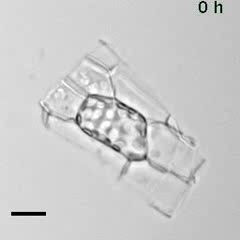Research
“Paths are made by walking.”
- Franz Kafka -

芽生えた大地が一生の生活の場となる植物は、不都合な環境においても逃げることなく耐え忍ぶ必要があります。そのため、植物は外部環境変化に対して実に巧妙な反応を進化過程で獲得してきました。私達のグループでは、植物の光応答など様々な環境応答過程を明らかにするため、「生きている細胞を観続けること」に重きを置いて研究を展開しています。
植物の細胞小器官の配置制御のしくみとその機能




植物細胞内の細胞小器官(オルガネラ)の分布や数を決めるしくみを解明する研究をしています。植物のからだを構成する細胞には、その機能を支える細胞小器官が存在します(図A)。細胞小器官の数は細胞に制御され、その分布も無秩序に分散するわけではなく、 分化状態や外部環境に応じて、適切な「時」に適切な「場」に適切な「数」で分布することが知られています。このことは細胞小器官の配置や数は細胞の機能発現に重要であると考えられますが、どのように決められているかはほとんどわかっていません。そこで、私たちは、主にヒメツリガネゴケ(図B)を用いて、蛍光タンパク質を用いて細胞骨格を可視化した細胞株(図C)や有機合成化学プローブ(図D)を用いて、細胞小器官の適材適所・適時適数を決めるしくみとその機能に着目して研究を行っています。
植物細胞の伸長のしくみ




植物が障害物に遭遇したときの応答について研究しています。植物細胞は、細胞壁を外側に押し広げる細胞内圧(膨圧)を維持しています。膨圧は植物細胞の伸長に重要な役割を果たしています。特に、花粉管や根毛は部分的に柔らかい細胞壁をもち、細胞の先端部分が伸長する先端成長と呼ばれる伸長様式をします。自然界では先端成長細胞はとても狭い隙間を通り抜けなければならない状況に遭遇すると考えられます。花粉管は受精のため雌組織の狭空間を伸長し(図E)、根毛は水分や栄養分を吸収するため土壌粒子の狭隙間を伸長します(図F)。そこで、細胞よりも小さなマイクロ流路を作製して調べたところ(図G)、1マイクロメートルの隙間を通り抜け伸長や分裂を続ける能力があることが分かりました(Yanagisawa et al. 2017 7 1403)。現在、わたしたちは靭やかで力強い反応を生み出すしくみを、近赤外蛍光性の細胞壁染色(図H)を用いたライブイメージングを駆使して研究しています。
植物ホルモンフローアトラスの構築




植物ホルモンの「移動速度」と「移動方向」を明らかにしようと研究しています。植物の発生、分化、生長過程、そして外部環境に対する応答には、多くの植物ホルモンが関わっています(図I)。なかでもオーキシンは、その存在が140年以上前から予見され、極性輸送という概念がダーウィン親子によって提唱されました。例えば、植物の芽が光に向かって生長する光屈性は、オーキシンが光とは反対方向に移動して細胞伸張を促すというモデルで説明されています(図J)。オーキシン作用機作を明らかにするため、これまでに卓越した分子ツールも開発されてきました(図K)。しかし、最も解析が進んでいるオーキシン研究でさえ、オーキシンが細胞を移動する様子はいまだに捉えられていません。そこで私達は、有機合成化学者とともに、蛍光性の植物ホルモンを開発し、その細胞間移動を直接可視化することにより、植物ホルモンフローアトラスの構築に貢献します(図L)。本研究は、植物科学者、有機合成化学者、計算化学者が一緒になって楽しく研究しています。
植物が再生力を発揮するしくみ

M

N

O

P
植物がもつ驚異的な再生力の謎を解明しようと研究しています。卵細胞と精子(精細胞)が受精した受精卵は、分裂して特殊な役割を担う様々な分化細胞を生み出します。受精卵のように様々な分化細胞をつくることができる細胞のことを多能性幹細胞と言います。一方、特殊な役割をもつ分化細胞も、環境が整えば多能性幹細胞になることがあります。この現象はリプログラミングと呼ばれます。植物は、切り株からひこばえが生えたり(図M)、挿し木によって増えたりすることから、リプログラミングしやすいと考えられています。特に、コケ植物蘚類のヒメツリガネゴケは、桁外れに高いリプログラミング能力があります。ヒメツリガネゴケの茎葉体において(図N)、葉の細胞に分化した細胞はもう分裂しません。ところが1細胞だけ取り出すと、幹細胞になり分裂を開始します(動画N)。その後の発生過程を観続けたところ、再び葉の細胞をもつ植物個体にまで再生することがわかりました(Sato et al. 2017 Sci Rep 7 1909)。一方、隣接した2細胞を取り出した場合には、どちらか一方の細胞しか幹細胞になりません(動画P)。幹細胞化した細胞は隣接細胞の幹細胞化を抑制していると考えられますが、一体どのようなしくみが働いているのでしょうか。幹細胞化する仕組み、幹細胞化を抑える仕組みの詳細はまだまだわかっていないことばかりです。幹細胞化のしくみがわかると、植物育種上の様々な課題の解決、ひいては農作物の生産効率の向上にもつながることでしょう。そこで私達は、一細胞解析装置やAIロボット技術などを駆使して植物幹細胞の不思議の解明に取り組んでいます。
上記は、研究テーマのごく一部です。実験室には、分子生物学実験設備、生化学実験設備の他、光反応を誘導、観察するマイクロビーム照射装置や赤外線観察顕微鏡が整備されています。また、佐藤がセンターチーフを務める名古屋大学ライブイメージングセンターの最先端イメージング機器も使用できます。さらに、微細加工技術によるマイクロ流路作成や有機合成技術による新規蛍光プローブ開発などの異分野技術を日常的に用いることができます。上記のテーマに興味のある方、まだ誰も知らない手つかずの現象を発見し分子機能までを追求したい方、現在手がけている研究テーマを最先端イメージング技術、微細加工技術、有機蛍光プローブなどを用いてさらに発展させたい方の参加も歓迎します。
